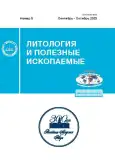No 5 (2023)
Articles
Chemical Composition of the Indian Ocean Pleistocene Sediments
Abstract
Geochemical review of Pleistocene sediments from the Indian Ocean has been performed based on reports of deep-sea drilling cruises and other literature references. We created the data base including more than 2000 chemical analyses of sediment samples. As result we compiled a number of tables concerning the mean ariphmetic composition of lithogenic and biogenic sediments. All data have been normalized on PAAS (PostArchean Australean shales). We revealed the dominant role of terrigenous clastics in formation of chemical composition of noncarbonate sediments and noncarbonated matter of planktic carbonates as well. Main geochemical associations have been established together with three main factors determinating sediment composition: terrigenous, carbonate and hydrogenous. We managed to calculate meanwheighted chemical composition, accumulation rates of elements in the studied sediments and their mass accumulation rates. All these parameters of the chemical composition can be used later for comparative analysis with analog para-meters from other ocean sediments within frames of Pleistocene straton in the World Ocean.
 423-444
423-444


Sources of Material for Surface Bottom Sediments in Some Regions of the Nordic Seas (According to Geochemical Data)
Abstract
The mineral, bulk chemical (main rock-forming oxides) composition and systematics of rare-earth elements, Sc, Cr, Zr and Th of surface bottom sediments taken in a number of cruises of the R/V Akademik Mstislav Keldysh in the Nordic Seas (Mona, Knipovich, Kolbeinsey and Aegir ridges, the basins of the Norwegian and Greenland seas, the continental slope of Svalbard, the western continental margin of the Barents Sea, etc.) are considered to determine the sources of fine-grained material of bottom sediments. If for coastal sediments the primary influence of terrigenous drift is obvious, then seaward sediments are affected by “relatively war-mer” Atlantic waters, leading to their dilution with calcium carbonate, the main producers of which are planktonic foraminifers. It is concluded that the source of fine-grained aluminosiliciclastics for most of the studied samples were both acidic and basic igneous rocks (volcanic rocks of Iceland) in different proportions.
 445-472
445-472


Thermobaric Conditions of Organic Matter Catagenesis in the Russian Segment of Barents Region Archipelagos (Franz Josef Land, Novaya Zemlya)
Abstract
The natural bitumen (NB) localization finds in the archipelagos of Russian Arctic Western segment is considered. The nature of their appearance in connection with the geothermal regime of the subsurface is discussed. Based on numerical simulation, temperatures and heat flow density are calculated in 2D geometry along seismogeological profiles and in 3D geometry for the Franz Josef Land isometric structure. It is concluded that all the noted NB manifestations are genetically related to hydrothermal activity, the signs of which are adequately recorded in the geotemperature field.
 473-498
473-498


Composition Peculiarities of the Upper Devonian Coaly Rocks (The Sula River Section, North Timan)
Abstract
A detailed coal-petrographic and mineralogical-geochemical study of humic coals and coaly rocks in the Sargaev deposits of the Upper Devonian of the Northern Timan (Sula River), which is an example of the burial of the most ancient coal-forming plants, has been carried out. The following types of organic rocks are identified in the section: “jet-like” coal, liptobiolitic silty-clayey coal, and silty-clayey-coaly mixtolites. The studied coals and coaly rocks are composed of humic organic components, represented by vitrinite and liptinite macerals, the inertinite group is of subordinate importance. Vitrinite macerals include gelinite, collotelinite, and telinite (xylenite), liptinite macerals include sporinite, cutinite, liptodetrinite, bituminite, alginite, and a resinous substance, and inertinite macerals include inertodetrinite, semifusinite, fusinite, and funginite. The level of organic matter maturity according to the vitrinite reflectance RV = 0.45–0.55%, corresponds to the transition from proto- to meso-catagenesis (gradations PC3–MС1). The mineral component of mixtolites and high-ash coals consists of kaolinite, chlorite/smectite (with a predominance of the chlorite component) and quartz.
 499-514
499-514


Continental Genesis of Sands of the Novolutsk Member, Sablinskaya Formation of the Middle Cambrian (Northwestern Flank of the Moscow Syneclise)
Abstract
Despite the high degree of knowledge about Cambrian-Ordovician sandy sequence in the northwestern flank of the Moscow syneclise, some of its subdivisions are still poorly studied. For the first time the article provides a comprehensive lithological analysis of the textural and mineral-structural composition of the Novolutsk member sands, common in the west of the Leningrad region. This member conventionally belongs to the Sablinskaya Formation of the Middle Cambrian. Significant differences between the studied sands and the sands of other units of the formation are shown, and their analogues are found in the eastern sections of the Baltic-Ladoga glint. The lenticular occurrence, specific textural complex and coarse-medium-grained composition of the Novolutsk unit sands made it possible to prove their continental alluvial genesis and link them with the sedimentary environments of the earlier identified Putilovskaya member sands of the Sablinskaya Formation.
 515-524
515-524











